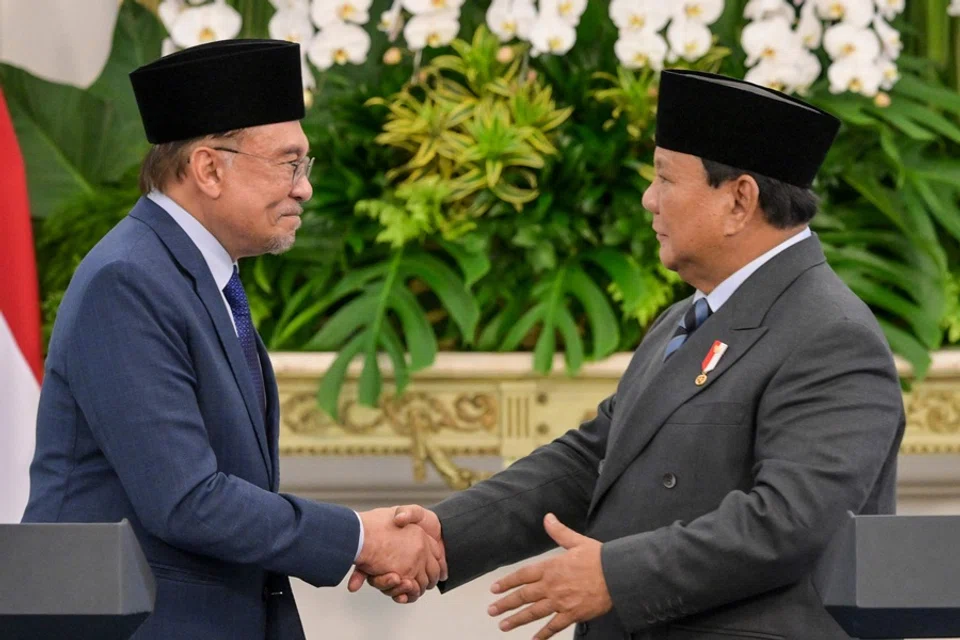Can the Ambalat deal be a model for the South China Sea?
The Malaysia-Indonesia Ambalat deal, if well implemented, will further reinforce the practice of joint development as a pragmatic and effective way and a diplomatic norm to handle territorial and maritime disputes, and could offer some lessons for dealings with China in the South China Sea disputes. Malaysian academic Ngeow Chow Bing explains.

On 27 June, during his visit to Indonesia, Malaysian Prime Minister Anwar Ibrahim announced with his counterpart, Indonesia’s President Prabowo Subianto, that both countries would jointly develop the Ambalat block.
The Ambalat block (Malaysia calls the area ND6 and ND7 and does not recognise the label “Ambalat”), located in the Celebes Sea east of Borneo, is a maritime area with overlapping claims between both countries. The agreement marks a significant step toward resolving the longstanding dispute by promoting bilateral cooperation in exploring and developing the area’s oil and gas reserves, which will also further strengthen diplomatic ties and contribute to regional peace and stability.
In 1979, the Malaysian government published the Peta Baru Menunjukkan Sempadan Perairan dan Pelantar Benua Malaysia (New Map Showing the Territorial Waters and Continental Shelf Boundaries of Malaysia), staking its maritime claims in the surrounding sea areas. The map was not recognised by any of its neighbours, including Indonesia. Both countries had long held negotiations over their maritime (including island) boundaries prior to 1979, with agreements over some areas in the Strait of Malacca and the South China Sea, culminating in the Continental Shelf Boundary Treaty in 1969.
Both sides managed to eventually diffuse the crisis, but the issue lingered on for years, with another flare up around 2008-2009.
Movement on long-drawn tensions
The dispute in the Celebes Sea, however, was difficult to resolve due to the overlapping claims of not only the maritime boundaries but also the sovereignty of two island features, Pulau Sipadan and Pulau Ligitan.
In 1979, when Malaysia published its map, the two islands were included as Malaysia’s territory by virtue of their location within the maritime boundaries claimed by Malaysia. Indonesia protested Malaysia’s map and claimed that Malaysia’s action violated an alleged verbal understanding reached by both sides, in 1969, that the status of the islands shall be negotiated at some point later.
Malaysia denied the existence of such an agreement, asserting that the islands have always been part of British North Borneo (Sabah) and, since Sabah joined Malaysia in 1963, sovereignty over the two islands belongs to Malaysia.
In 1982, Indonesia dispatched its navy to Pulau Sipadan to “investigate foreign troops”. This was the first reported confrontation over the dispute in the Celebes Sea, and in subsequent years, more mutual accusations were traded between both sides.
Both countries established a Joint Working Group in 1992 to negotiate the dispute, but failed to achieve a breakthrough. With the issue stalemated, both sides finally agreed to refer the dispute to the International Court of Justice (ICJ).

The ICJ delivered a verdict favourable to Malaysia in 2002 over the two island features, but did not settle the overlapping maritime boundaries. Tensions between Malaysia and Indonesia escalated periodically over the area.
In early 2005, Malaysian national oil company Petronas granted Shell a concession in the area, which resulted in the most serious military standoff between the two countries in years, with several incidents of collisions of naval vessels reported, while Indonesia’s military buildup near the contested waters accelerated. Both sides managed to eventually diffuse the crisis, but the issue lingered on for years, with another flare up around 2008-2009.
This new agreement between Malaysia and Indonesia, if well implemented, will further reinforce the practice of joint development as a pragmatic and effective way and a diplomatic norm to handle territorial and maritime disputes.
Normalising joint development as dispute management mechanism
Details of the Ambalat joint development deal remain inaccessible to the public, but the deal itself is a significant arrangement that should remove the dispute as an irritant in the bilateral relations. Both countries had earlier signed two maritime boundary agreements in June 2023, having reached agreement on territorial sea delimitation in the southern portion of the Strait of Malacca and the Celebes Sea, and the Ambalat joint development proposal will further consolidate the gains in settling boundary issues.
The Ambalat agreement is consistent with the United Nations Convention of the Law of the Sea (UNCLOS), which, in its Articles 74 and 83, stipulates that states parties with conflicting and overlapping maritime claims, “in a spirit of understanding and cooperation, shall make every effort to enter into provisional arrangements of a practical nature and, during this transitional period, not to jeopardize or hamper the reaching of the final agreement.”
Malaysia is also not new to joint development of oil and gas reserves in disputed maritime areas, having struck joint development agreements with Thailand and with Vietnam over the southern edge of the Gulf of Thailand. Indonesia had a joint development arrangement with Australia in the Timor Gap before the independence of Timor Leste in 2002.
This new agreement between Malaysia and Indonesia, if well implemented, will further reinforce the practice of joint development as a pragmatic and effective way and a diplomatic norm to handle territorial and maritime disputes.
Both leaders fending off domestic pressure
Both Anwar Ibrahim and Prabowo Subianto, upon coming into their respective offices, have demonstrated some willingness of flexibility when it comes to the sensitive issue of managing the various boundary disputes confronting their countries, although not without controversy and pushback.
Anwar apparently indicated that Malaysia was “prepared to negotiate” with China over the South China Sea dispute during his visit to China in early April 2023, although he had to subsequently walk back from that remark, and the Ministry of Foreign Affairs clarified that Malaysia’s position on the South China Sea remained unchanged.
Although the Indonesian Ministry of Foreign Affairs tried to walk back somewhat from the proposal, Prabowo was unfazed by the huge controversy such a proposal provoked.
Nonetheless, with Anwar’s strong blessing, Malaysia did agree to the bilateral maritime dialogue mechanism with China (first launched in October 2024), a mechanism that some within the Malaysian diplomatic establishment opposed exactly because of the fear that it might lead to an eventual process of “negotiation”. Anwar also faced criticisms over the Ambalat joint development arrangement with Indonesia, with opposition and Sabah-based politicians claiming that national sovereignty and the state’s interests have been compromised with little consultation with stakeholders.

On the Indonesia side, the China-Indonesia Joint Statement, released in the wake of Prabowo’s visit to China in November 2024, notably contained a clause which stipulated that “[t]he two sides reached important common understanding on joint development in areas of overlapping claims and agreed to establish an Inter-Governmental Joint Steering Committee to explore and advance relevant cooperation based on the principles of ‘mutual respect, equality, mutual benefit, flexibility, pragmatism, and consensus-building,’ pursuant to their respective prevailing laws and regulations”.
Although the Indonesian Ministry of Foreign Affairs tried to walk back somewhat from the proposal, Prabowo was unfazed by the huge controversy such a proposal provoked. It remains to be seen, however, how such a proposal between Indonesia and China will materialise.
The Ambalat arrangement certainly reinforces joint development as a norm, enhances rule-based maritime governance in the region, and shows that regional leaders, with determined will, can take decisive actions that turn an impasse into a breakthrough.
Lessons for handling disputes in the South China Sea
Will the Ambalat deal give further impetus to joint development in the South China Sea?
The Ambalat arrangement certainly reinforces joint development as a norm, enhances rule-based maritime governance in the region, and shows that regional leaders, with determined will, can take decisive actions that turn an impasse into a breakthrough. China, of course, has been pushing for “shelving the dispute and pursuing joint development” in the South China Sea for decades, but with very little positive response in the region, the recent apparent agreement with Indonesia being the only exception.
The Ambalat arrangement hence echoes China’s call for joint development in disputed areas, while also being consistent with international law. The implementation of the Ambalat joint development also adds to the corpus of references and cases to develop legal and operational templates that could be useful for future agreements on hydrocarbon exploration, shared revenue arrangements and coordinated environmental protocols in any joint development projects in the South China Sea.
Like the dispute in the South China Sea, the Malaysia-Indonesia dispute in the Celebes Sea also involves both the maritime (Ambalat block) and land (Pulau Sipadan and Pulau Ligitan) dimensions, and the dispute over the land was first resolved (with Malaysia’s ICJ victory) before the maritime dispute. This is also similar to China’s argument that the core of the South China Sea dispute is the territorial disputes over the maritime land features (the four “shas” in China’s terminology), before the maritime dispute can be settled.
Whether it is the “dashed-line” or the “four shas”, China’s claims in the South China Sea remain incomprehensible in terms of international law for most policymakers and officials in the region.
Nonetheless, the Ambalat joint development is an arrangement meant to cope with the conflicting interpretations of maritime boundaries following the provisions provided in UNCLOS. Essentially, each side recognises that there is a dispute and there is a common and well-recognised international legal framework for both sides to work on. This will further give confidence to the regional countries with outstanding disputes to manage or even resolve their differences on the basis of a common legal framework.
However, the common legal basis for Southeast Asian claimant states recognising a dispute with China in the South China Sea is either absent or, at best, extremely weak. Whether it is the “dashed-line” or the “four shas”, China’s claims in the South China Sea remain incomprehensible in terms of international law for most policymakers and officials in the region.
In addition, although both Anwar and Prabowo likely will eventually prevail over their domestic critics in pushing through the Ambalat deal, the domestic political pressure (more notable for Anwar) is real. This will be even more so the case in any hypothetical joint development deal with China in the South China Sea.





![[Big read] China’s 10 trillion RMB debt clean-up falls short](https://cassette.sphdigital.com.sg/image/thinkchina/d08cfc72b13782693c25f2fcbf886fa7673723efca260881e7086211b082e66c)